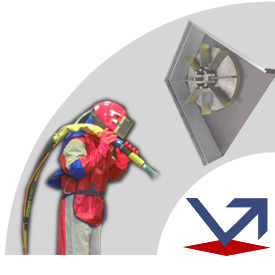 Mechanical surface preparation consists in suitably preparing the surfaces of various metal workpieces before they are submitted to treatment like painting, galvanizing, thermally metalizing, etc. The technique most commonly chosen for mechanical surface preparation is the pneumatic blast technique which enables the highest level of purity and a well-defined degree of roughness of the workpiece surface to be achieved.
Mechanical surface preparation consists in suitably preparing the surfaces of various metal workpieces before they are submitted to treatment like painting, galvanizing, thermally metalizing, etc. The technique most commonly chosen for mechanical surface preparation is the pneumatic blast technique which enables the highest level of purity and a well-defined degree of roughness of the workpiece surface to be achieved.
The primary purpose of the treatment is to remove any contaminant like rust, scale, old paint coating residues, etc. An equivalent purpose is to impart a suitable structure to the workpiece material to achieve its being perfectly well bonded to the protective coating and thus to enhance the protective power against corrosion.
Principle of operation
The pneumatic blast treatment involves an abrasive blast projected at a high speed toward the surface to be cleaned. In spite of their low mass, individual abrasive particles impinge on the surface with a high kinetic energy associated with their high speed which results in effectively separating the contaminants from the treated surface.
By reference to the nature of the element which imparts the kinetic energy to abrasive particles, our classification distinguishes the pneumatic and the turbine techniques.
The pneumatic technique relies on compressed air as the energy-imparting element. The equipment involved comprises blastrooms.
The turbine technique makes use of an ejection wheel. The equipment used by this technique includes, among other things, wheel blast machines. The machine is based on the centrifugal force (ejection) principle. The spherical steel shot abrasive jet is produced by a high–speed ejection wheel. The wheel’s perimeter includes a pass-through hole through which the abrasive is directed onto the workpiece surface.
A correct preparation of the workpiece surface prior to the formation of a top layer or of a protective coating, is quite essential for its future long service life. Incorrect pretreatment of the workpiece surface results in numerous adverse post-effects which include:
- Reduced adhesive attraction of the coating to the substrate
- Reduced surface smoothness
- Sub-coating corrosion
